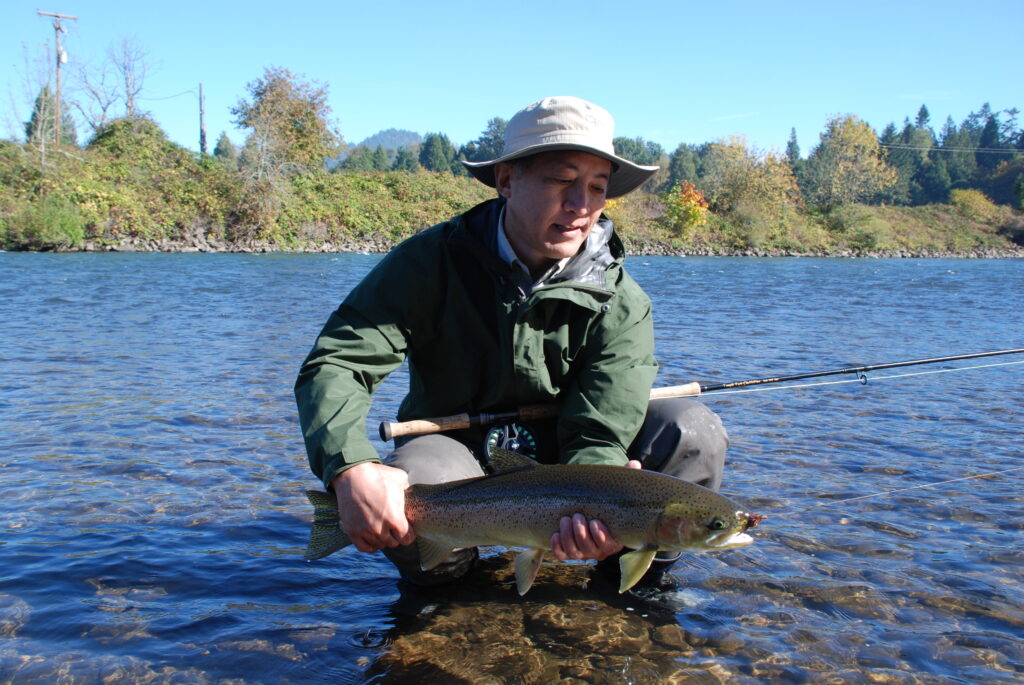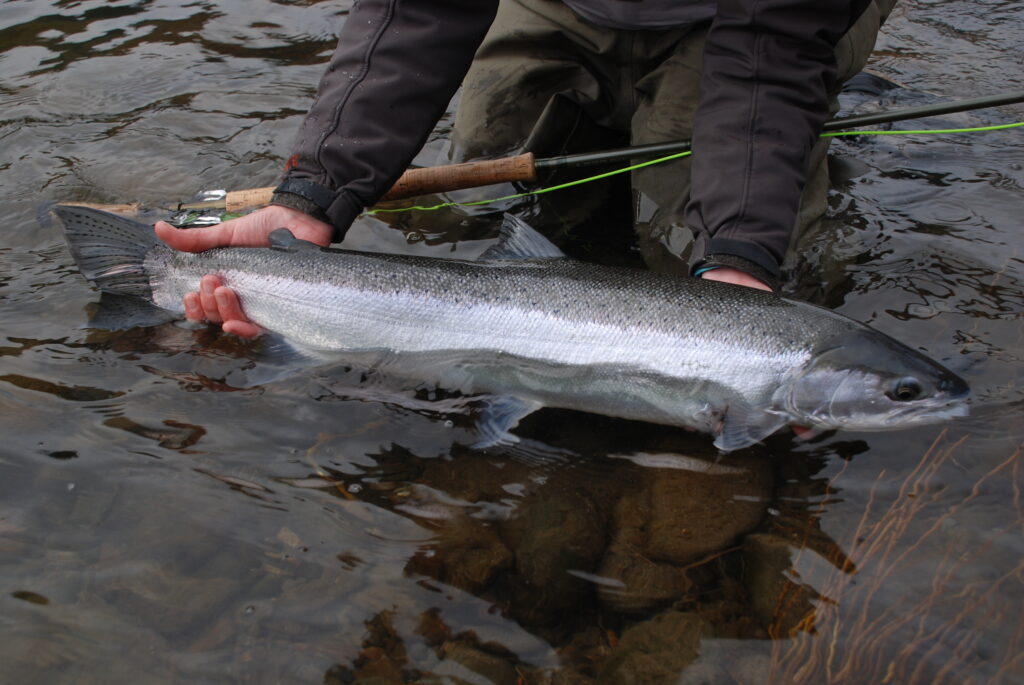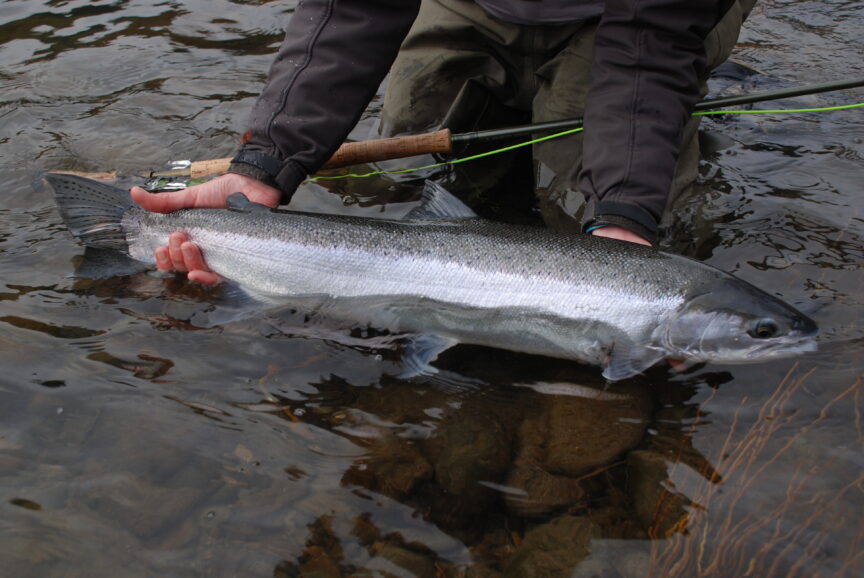
By Dean Finnerty
Dean Finnerty is the manager of Wild Steelheaders United as well as the Pacific Northwest Director for TU’s Angler Conservation Project. Prior to working in conservation, Finnerty worked as an undercover narcotics officer by night and a fly fishing guide on the famed North Umpqua fly water by day. Learn more about Dean here, or checkout John McMillan’s podcast profile of the man, the myth, the legend, Dean Finnerty.
When it finally happens, you’ll know. First, you’ll feel an unmistakable sensation of weight, building and causing an ever-deepening bend in your rod. Then you’ll feel your brain, now infused with adrenalin, on fire with the realization that a steelhead has indeed grabbed your swung fly.
Consistently catching steelhead on a swung fly is challenging, for sure. But isn’t that part of the joy and intrigue that has drawn you to it? To catch these magnificent creatures on your own terms?
You likely started out pursuing steelhead using a variety of conventional tackle and techniques. All of it good, likely even great. But now, you want to check out the greater challenge – and some would say thrill – of steelhead fishing in the time-honored tradition of swinging a fly.

Below are several tips that should improve your odds of having encounters with steelhead fishing a swung fly more frequently than simply “once in a lifetime.”
- Choose a river and learn it well. Find those places that are ideally suited to your tackle and presentation. This means runs that have lots of structure like boulders and ledges. Steelhead LOVE structure! Spend time swinging flies in water that is 3’-5’ deep. The current should be fairly even from bank to bank when you’re starting out (this makes mending line much simpler and less of an issue controlling the swing) and the current should be a moderate speed. Don’t waste precious fishing time in areas that you can’t effectively cover with your fly gear. Really fast, deep water that you could fish easily with your convention tackle isn’t what you’re looking for with a fly rod.
- Worry less about your fly pattern and more about the presentation. There are literally thousands of steelhead fly patterns in every conceivable color, size and style. Pick one that is black in color. Like Henry Ford once said, “You can have it any in color you want, as long as it’s black.” I’m also darned fond of black/blue and natural tones like tan and olive. What is paramount is how you present the fly. The presentation must be smooth and steady, down and across without too much speed and consistently and rhythmically progressing down the run. To expand a bit on this point – no one really knows “why” a steelhead takes a fly. But they respond best when the fly is fished under tension and seductively swims under the tension provided by current and fly line/leader. Current and line tension cause the fly to “come alive” and draw the interest and attention of steelhead lying in the run. Keeping the “downstream progression” is also huge. This is the “cast, step, cast” mantra that all experienced steelhead fly fisherman live by. The ONLY time I ever make the same cast twice, from the same position is if I’ve seen a flash or boil from a fish turning on the fly or if I’ve felt a tug or some indication that a fish has tried to take the fly. Then I’ll give another cast and swing to the same spot, otherwise I’m always moving downstream between every swing.
- Gear selection and choice should take into account the water conditions, (i.e. temperature and time of year, (summer vs. winter)) average size of the fish you expect to encounter, and the size of the fly you plan on fishing. In summer, I fish full floating lines and smaller flies. In my region, summer steelhead rarely exceed eight pounds. In winter, I fish sink-tips of various length and density (sink rate) and my flies are usually medium to larger sized (always with lots of life-like movement built in) and my fish may reach into the mid-teens, but most average around ten pound or less. There has never been a better tool for swinging flies than a spey rod. Ninety percent (or more) of the time I fish a spey rod that is 12’6” or 13’ long and is rated to throw a line that weighs from 350-550 grains. Steelhead are not generally too leader shy, so I usually fish 12 lb. tippet. Again, floating lines in the summer/fall and floating line with sink-tips in the winter/spring. Keep it simple.
Swinging flies is just one of many ways to enjoy your time on the water pursuing these incredible creatures. But it’s a particularly satisfying way. Understand the kind of water you want to fish, cast a straight line, swing your fly down and across, step down the run. It won’t take long to get the hang of it, especially if you watch more experienced fly anglers do it. These tips – and a little good fortune — will soon provide you with one of life’s most amazing experiences, a steelhead on a swung fly!


